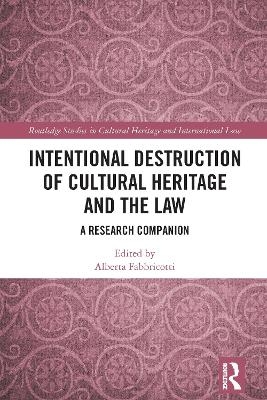
Intentional Destruction of Cultural Heritage and the Law
Routledge (Verlag)
978-1-032-46744-3 (ISBN)
The world has been shocked by the destruction of world cultural heritage sites over the past two decades, as seen in widely disseminated videos depicting events such as the demolition of the Buddhas of Bamiyan and the ancient Syrian city of Palmyra. These acts are perhaps the clearest and most glaring examples of what is meant by the ‘Intentional Destruction of the Cultural Heritage of Humankind’ (IDCHH).
The book explores in detail the remedies against IDCHH available under international law. These remedies are defined as all the lawful responses provided for both by customary law and by the special responsibility regimes created under the many substantive areas of international law. The examination includes UNESCO instruments and UN measures for the maintenance of international peace, mechanisms for the protection of human rights and those for the protection of investments, and international criminal justice outcomes through the decisions of the Permanent Criminal Court. Thus, the book explores avenues for response such as appeals to international courts, peacekeeping operations and referrals to the criminal legislation of States, in addition to reparations. The concept of the Cultural Heritage of Humankind implies that IDCHH harms all States and all peoples and human groupings in the world, not only the State or people on whose territory the cultural property is located. The book identifies the international law avenues for subjects not directly injured by IDCHH to obtain its cessation and reparation.
This book is essential reading for students, academics and practitioners exploring international law and the destruction of cultural heritage.
Alberta Fabbricotti is Associate Professor of International Law at the Department of Legal and Economic Studies, Faculty of Law, La Sapienza University, Rome. She teaches International Law and EU Law. She is a member of the Teaching Staff Council for the doctorate in Public, Comparative and International Law, Programme in International Order and Human Rights. Alberta has published three monographs and many articles and essays in the fields of international economic law, international protection of human and peoples’ rights and refugee law. She headed and still is the director of several research teams under the funding of La Sapienza University. She also works as an expert reviewer for the EU Commission, Italian National Agency of University System and Research Evaluation (ANVUR), the Polish National Science Centre (NCN) for the Arts, Humanities and Social Sciences, and Italian Ministry of Education, Universities and Research (MIUR) for the evaluation of research projects and results.
1. The Intentional Destruction of the Cultural Heritage of Humankind: What Are the Remedies under International Law? Preliminary Considerations Part 1. The (Re)Actions against IDCHH in the UN System Section 1. The UNESCO: Achievements and Shortcomings 2. State Responsibility for the IDCHH between UNESCO Rules and ASR 3. Sanctioning Cultural War Crimes: From the 1954 Hague Convention to National Legislations 4. The 2003 Declaration concerning the Intentional Destruction of Cultural Heritage: A Step Back? 5. The Italian/UNESCO Task Force and Other Initiatives 6. Unpacking Expert Authority: The Case of Italy's Unite4Heritage Taskforce Section 2. The Relevance of IDCHH as A Threat against International Peace and Security 7.The Security Council Resolutions addressing IDCHH 8. IDCHH: What Role for UN Peacekeeping Operations? 9. The UN Counter-Terrorism Committees and the Sanctions against Individuals Part 2. The Reparation for IDCHH in the Jurisprudence of the Human Rights Courts 10. The Preliminary Question of the Nature of the Rights infringed by IDCHH: Individual, Collective or Group Rights 11. Cultural Heritage as a Human Right in Times of Peace and Conflict: Measures of Legal Protection 12. The “Victim” of IDCHH and the Entitlement to Submit a Claim 13. Forms of Reparation and Avenues for Enforcement under International Human Rights Mechanisms Part 3. The Remedies under International Investment Law 14. International Investment Law and the Protection of Cultural Heritage: Reconciling State Obligations, Building Investors’ Duties 15. The Avenues for Obtaining Redress for IDCHH under the International Investment Law 16. A Critical Analysis of Compensation in Investment Arbitration related to Potential IDCHH 17. Remedial Options after the Destruction of the Juukan Gorge Caves: A Lost Cause (of Action)? Part 4. The Punishment of the Destroyers under International Criminal Law 18. IDCHH as a War Crime: Which Effectiveness for the Current Legal Framework? 19. IDCHH as a Crime against Humanity 20. The Al Mahdi Case between Erga Omnes Obligations and Right to Reparation: the International Community as a Victim or as a Donor? 21. Rationales for the Protection and Destruction of Cultural Heritage: A Missed Opportunity for Clarification in the Case of Al Mahdi 22. The Collective Interest at the ICC: International Community as a Victim of International Crimes 23.The 2021 Policy on Cultural Heritage of the ICC: New Perspectives and Uncertainties of Criminal Justice 24. The Criminalization of the Intentional Destruction of Assets belonging to Humanity’s Cultural Heritage 25. The Intentional Destruction of the Cultural Heritage of Humankind: What Are the Remedies under International Law? Final Considerations
| Erscheinungsdatum | 02.08.2024 |
|---|---|
| Reihe/Serie | Routledge Studies in Cultural Heritage and International Law |
| Zusatzinfo | 1 Tables, black and white |
| Verlagsort | London |
| Sprache | englisch |
| Maße | 156 x 234 mm |
| Gewicht | 1043 g |
| Themenwelt | Kunst / Musik / Theater |
| Reisen ► Reiseführer | |
| Geisteswissenschaften ► Geschichte ► Hilfswissenschaften | |
| Geschichte ► Teilgebiete der Geschichte ► Kulturgeschichte | |
| Sozialwissenschaften | |
| ISBN-10 | 1-032-46744-4 / 1032467444 |
| ISBN-13 | 978-1-032-46744-3 / 9781032467443 |
| Zustand | Neuware |
| Haben Sie eine Frage zum Produkt? |
aus dem Bereich


